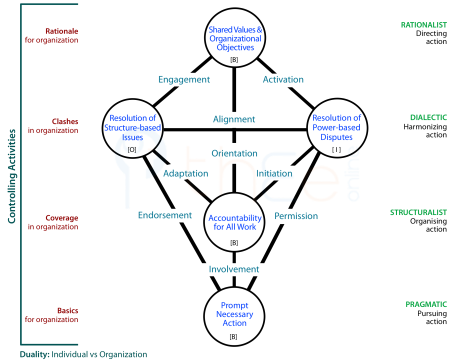Getting Action Right
All achievement rests on , i.e. organizations have a pragmatic foundation. The higher 9 Centres are then all about one single important thing: how to ensure that serves the achievement goals of the organization.
By dividing the framework in two sections, primarily linked by , we can see three foci in the Tree diagram for delivering that «single important thing».
■ The lower section is concerned with controlling activities.
■ The upper section is concerned with ensuring effectiveness.
■ These two sections are linked so as to manage achievement tensions.

Controlling Activities
The lower section, CL4-CL1, is about controlling activities.
. All work shows up in specific activities, so the most basic requirement for achievement is (CL1). is intrinsically controlling.
. However, unless all necessary actions are performed when and as they should be, the organization will founder. Coverage of precisely what counts as «necessary» is provided by a . The structure must cover not only actual and self-evident work, but also all potentially possible work. So it must be designed in terms of «» in particular areas. This level organizes action.
. Clashes of perspective, outlooks and interests are unavoidable. However, ![]() two different types of clash are possible: ►
two different types of clash are possible: ►

If such clashes persist, they can paralyze action. Accountable managers must find resolutions that harmonize action within the organization.
. All activity needs to be controlled by the values and objectives of the organization. Values and goals direct action. To the degree that activity delivers on goals in accord with values, the organization can claim achievement.
● Errors in mean «doing the wrong thing».
● Errors at mean «doing things wrongly».
Control is Not Enough
The upper section, , is about increasing effectiveness and this primarily involves bringing reality into the picture for the organization. There are three relevant realities to be determined by inquiry: , and .
The diagram shows that in the is the primary link between the higher that increase effectiveness and the lower that control activity.
There are two other Channels linking the two halves of the Tree via . These links directly address duality-based tensions: bridging both the «inquiry v action» internal duality and the «individual v organizational» dynamic duality.
![]() NOTE: The is the wild card: not only does it lack a direct link to , but it can bypass —and will certainly do so if roles and reporting relationships are confused and weak.
NOTE: The is the wild card: not only does it lack a direct link to , but it can bypass —and will certainly do so if roles and reporting relationships are confused and weak.
► Read more about improving control.
Originally posted: 29-Sep-2011